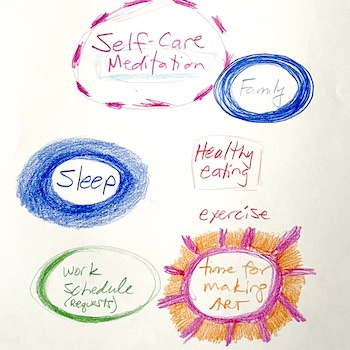Healthy Boundaries - January 17, 2022
 Sometimes it can be difficult to define our personal boundaries, especially as a caregiver. Physical and emotional boundaries are necessary to help keep us healthy, but many of us feel guilty when we put our own needs first and practice self-care. But, if we don’t put our needs first and take care of ourselves, then the process of taking care of others can lead to resentment and exhaustion. Which can lead to emotional and physical problems.
Sometimes it can be difficult to define our personal boundaries, especially as a caregiver. Physical and emotional boundaries are necessary to help keep us healthy, but many of us feel guilty when we put our own needs first and practice self-care. But, if we don’t put our needs first and take care of ourselves, then the process of taking care of others can lead to resentment and exhaustion. Which can lead to emotional and physical problems.
As a caregiver our services, time, and energy are needed to help others and (most of the time) caring for others is joyful. But what happens when our personal and emotional boundaries diminish? Maybe over time we extend ourselves a little bit more… and a little bit more… until we feel overwhelmed. This is a clear sign to reevaluate healthy boundaries and get ourselves back on track.
What do healthy boundaries look like?
When you think about what you need to live your best life, you can use your answers to develop your boundaries. Are you a morning person? Consider setting an appointment for yourself in the morning to meditate, or exercise, or read… Set that time aside and let family members know not to disturb you during that scheduled time.
Do you tend to say ‘yes’ to every request just because you know you can do the thing? Learn to say ‘no’ to requests that don’t fit in your schedule or fulfill your personal and career intentions. When you continue to say yes when you really want to say no it can lead to resentment very quickly. And putting too many things on our To Do list can leave us overwhelmed. Make yourself a priority on your calendar!
You can even block off time on your schedule to “do nothing”. Simply relax. When it’s on your schedule you don’t need to fight for it or try to fit it in between meetings and meal prep - reclaim your time.
Include everyone
When your family and coworkers are aware of your boundaries, it benefits everyone. Setting personal boundaries helps to model this healthy behavior for your family members. Setting boundaries at work encourages your team members to respect your time, which in turn will help them respect their own time. Everyone wins.
Try This
Grab your art supplies and try this art task:
- List areas in your life that you have (or want to have) boundaries. For example: your exercise time; your meditation / relaxation time; no work calls after work hours; no unannounced visitors at home…
- Next, draw a boundary line around that area as you envision the boundary to currently be - is it a solid line no one can pass? Is it a dashed line with large openings allowing more than necessary intrusions? Is there no boundary at all?
When you visually see how your boundaries are set up, you can reevaluate where you want to change them. Start respecting your time and space and show others how to do the same.
Connect with us:
The C.A.R.E. Program team would love to connect with you!
- Register for one of our Caregivers classes
- Join the conversation in our Facebook group
References:
- How to Set Healthy Boundaries
- Set Boundaries and Practice Self Care without Feeling Guilty
- Image above: Boundaries by Kelly Darke
.svg?iar=0&hash=F6049510E33E4E6D8196C26CCC0A64A4)

/hfh-logo-main--white.svg?iar=0&hash=ED491CBFADFB7670FAE94559C98D7798)